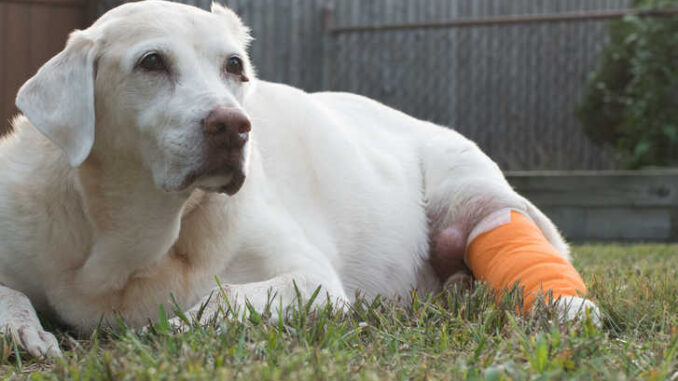
This article was updated on July 2nd, 2023
Mast cell tumors are one of the most common forms of cancer in dogs. They account for almost 20-25% of all skin tumors in dogs. In my practice, I see dogs with mast cell tumors weekly.
Mast cell tumors can pose challenges for dog owners because they can look like many different things and may not alarm an owner until they are quite large or bothersome. Sadly, I encounter many dogs whose tumors are left undiagnosed until it is too late to fully cure them. Mast cell tumors are very aggressive and must be treated as such to achieve a favorable outcome for the dog.
Mast cell tumors: what do they look like?
Mast cell tumors don’t have the same appearance. In fact, they can look like something as harmless as an allergic reaction, or insect bite. Often the mass will start out as a small raised bump. Below is a picture of a small mast cell tumor on a pug:
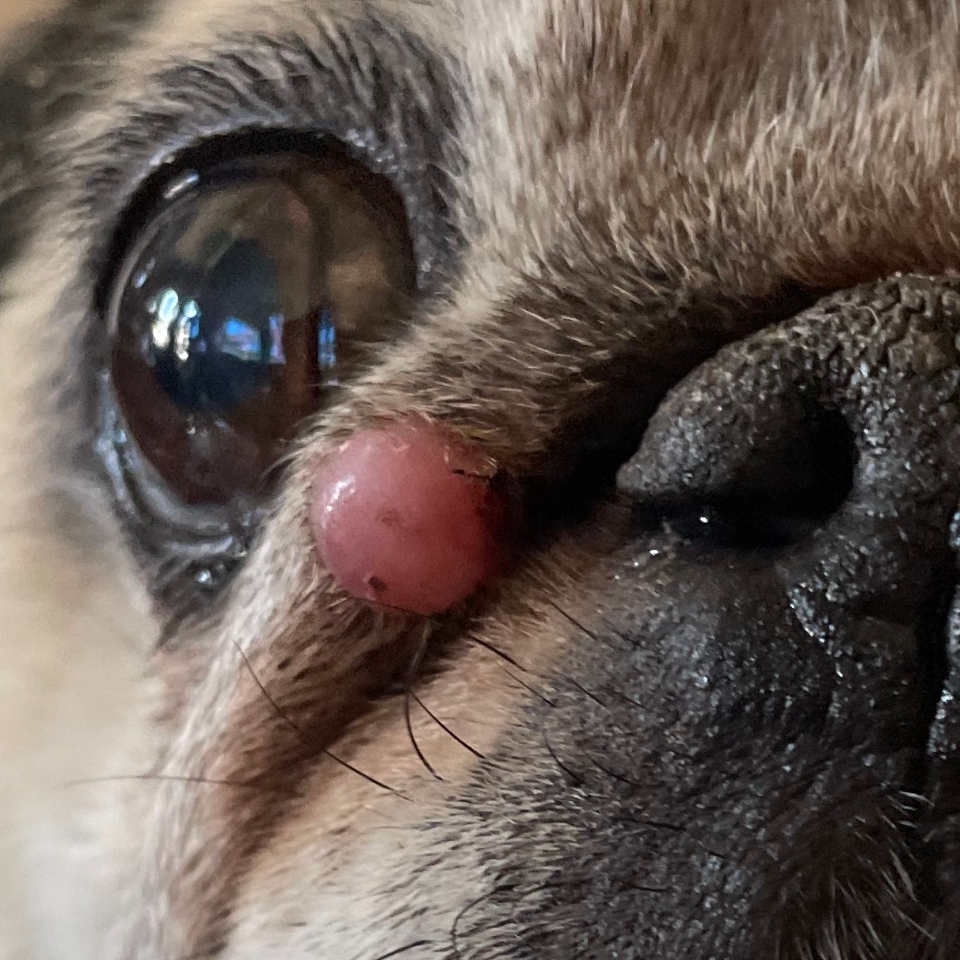
Mast cell tumors in dogs may occur anywhere on the body and vary in appearance. The masses often begin as a small, firm bump. The mass may grow rapidly and can vary in size from time to time. If left untreated, the mass may become red and ulcerated. Below is a picture of a large mast cell tumor:
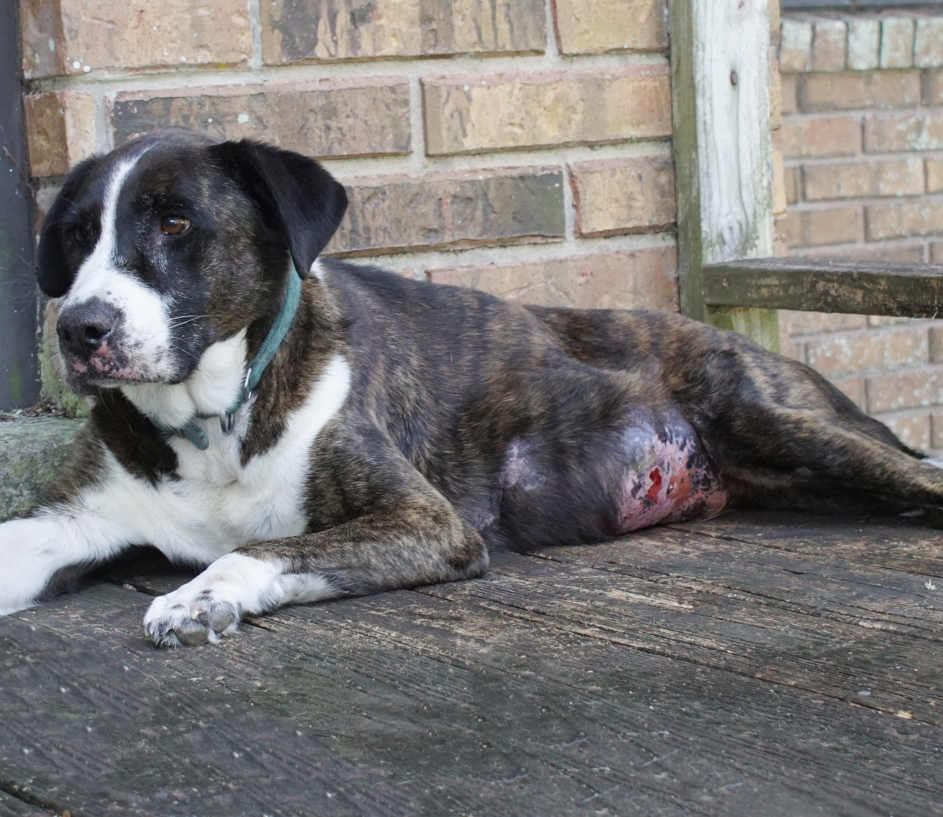
The tumors can vary in shape and size and can appear:
- Small
- Large
- Raised
- Flat
- Ulcerated
- Itchy
- Red, pink, or skin-colored
They occur most commonly in the skin but can be present in other areas of the body like the spleen, liver, intestinal tract, and bone marrow. Many dogs will only develop one skin tumor, but others can have multiple tumors on their bodies. View more pictures of mast cell tumors.
My dog has just been diagnosed with mast cell tumors: how will it evolve over time?
Now that you have a diagnosis, it may be helpful to know what to expect. A mast cell tumor, once diagnosed, should be immediately treated:
- Most commonly the tumor will be removed via surgery
- Some tumors may be eligible for an injectable treatment, Stelfonta™.
- Additional treatment, including chemotherapy and radiation may also be necessary.
- Palladia™, an oral anticancer medication, may be prescribed as well.
Mast cell tumors are complicated, and their behavior depends on their grade (a measure of aggressiveness) and their stage at diagnosis. Mast cells tend to spread into the areas surrounding them and recur frequently, even after removal.
A mast cell tumor that is not removed puts the dog at risk of a degranulation event. This occurs when the histamine granules in the tumor are suddenly released into the body. Degranulation may lead to sudden and fatal anaphylaxis, or in less severe casses, gastrointestinal bleeding and ulceration.
If your dog has a diagnosed mast cell tumor, your veterinarian may advise a consultation with a veterinary oncologist. A prognostic panel may be run on the tumor to get information about the genetic makeup and will aid the veterinarian in giving a more accurate prognosis.
What is a dog’s life expectancy and survival rate with mast cell tumors?
It is almost impossible to predict the exact life expectancy of a dog with a mast cell tumor. However, factors that contribute include breed, age, location of the mast cell tumor, and the grade and stage of the tumor. Learn more with our article about “Life expectancy of dogs with mast cell tumors“.
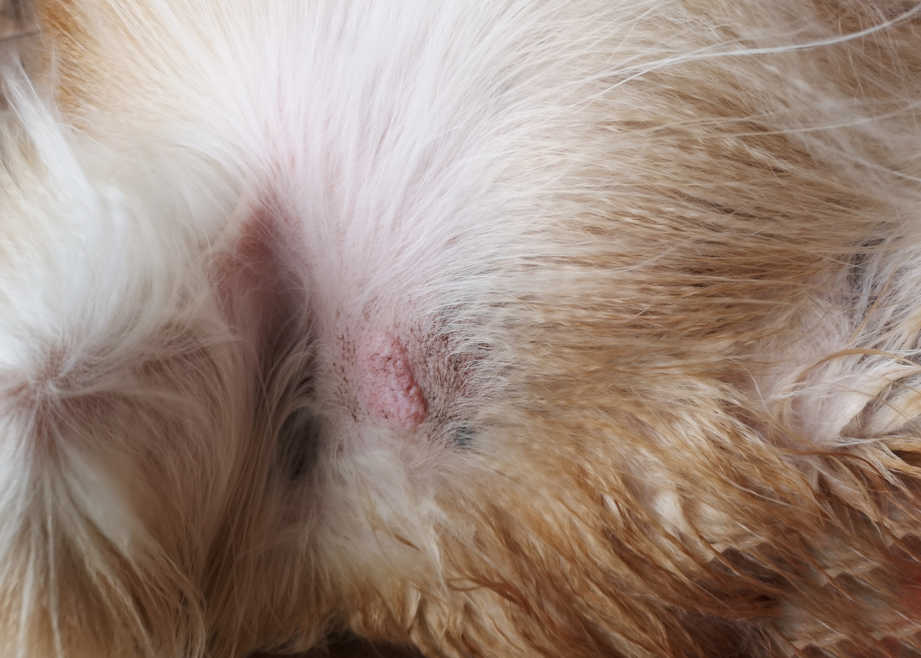
What are the different stages and grades of mast cell tumors?
The grading of mast cell tumors is determined by the microscopic appearance of the tumor and is designed to predict how the tumor will behave. Mast cell tumors are graded using two systems: the Patnaik system and the Kiupel 2-tier grading system. Note that there is no reliable way to know just from looking at a tumor what grade it is (Very small mast cell tumors may be high grade and larger tumors may be low grade):
3 grades of the Patnaik system:
- Grade I – well-differentiated cells that appear like normal mast cells
- Grade II – moderately differentiated cells and the tumors could have minor abnormalities when compared to normal mast cells. This grade can also invade into deeper fascial planes.
- Grade III – poorly-differentiated tumors that are quite invasive and aggressive.
Kiupel 2-tier grading system:
- Low-grade: minimal mitotic figures and nuclear changes
- High-grade: mitotic index of >7 with abnormal nuclei
Grading helps determine prognosis, aggressive behavior, and whether or not local treatment will be sufficient. Grade II-III or high-grade tumors have a worse prognosis.
Staging of the tumor refers to whether or not the tumor has already metastasized. There are four stages of mast cell tumors:
- Stage 0: A single skin tumor that has been incompletely removed without invasion of the lymph node
- Stage 1: A single tumor on the skin without lymph node invasion
- Stage 2: A single tumor on the skin, invading the lymph node
- Stage 3: Multiple skin tumors or infiltrating tumors that may or may not involve the lymph node
- Stage 4: Any tumor with distant metastatic disease to other parts of the body
- Substage A: No clinical signs of metastatic disease
- Substage B: Clinical signs of metastatic disease such as vomiting or diarrhea
Staging helps determine if treatment should be focused locally or if the entire body should be incorporated into the treatment plan.
Causes of mast cell tumors in dogs
The largest risk factor for mast cell tumors tends to be breed. Any dog may produce a mast cell tumor, but boxers are definitely predisposed. Other breeds, such as Boston terriers, bull terriers, golden retrievers, and labrador reterievers are also more likely to be affected.
Unfortunately, as is the case for all cancers, there is no one definitive answer as to what causes mast cell tumors. Why dogs develop tumors is complex and likely due to multiple factors, some environmental and some genetic.
We do know that genes play a role in the disease. We have identified several genetic mutations that are known to be involved in the development of mast cell tumors. These genes are passed from parents to offspring and should be considered in breeding programs.
What breeds commonly get mast cell tumors?
Mast cell tumors are more common in these breeds:
- Beagle
- Boxer
- Boston Terrier
- Bulldog
- Bull Mastiff
- German Shorthaired Pointer
- Golden Retriever
- Great Dane
- Labrador Retriever
- Pug
- Rhodesian Ridgeback
- Scottish Terrier
- Shar Pei
- Staffordshire Bull Terrier
- Weimaraner
Diagnosing mast cell tumors in dogs
Typically, mast cell tumors are diagnosed after an owner finds a suspicious lump and takes the dog to their veterinarian. The veterinarian will take a small sample from the mass with a needle and place the cells on a microscope slide. The slide sample will be sent to a veterinary pathologist who will look for the characteristics of mast cell tumors. If there is a concern for degranulation or the case requires grading and staging prior to removal, a larger sample in the form of a tissue biopsy may be performed.
Can you tell if your dog has mast cell tumors?
Unfortunately, there is no way for an owner to be able to tell if their dog has mast cell tumors. Mast cell tumors are notorious for looking like other things, including insect bites and cysts. Without proper testing with your veterinarian, it is impossible to know what is causing a mass on a dog.
Treatment options
Surgery is the required treatment for most mast cell tumors in dogs. If the tumor is low grade and has not spread, surgery may be curative if the surgeon is able to get clean margins (remove all of the tumor cells).
Sadly, with higher-grade tumors, even without evidence of spread, a combination of surgery and chemotherapy may be necessary. Mast cells that have metastasized to other locations in the body will require more aggressive, systemic therapies.
For mast cell tumors located on the legs, below the elbow and the hock, Stelfonta™ may be a non-invasive treatment option.
Are mast cell tumors in dogs curable?
Yes, some mast cell tumors in dogs are completely curable. Whether or not a complete cure can be achieved depends on many factors such as the location, stage, and grade of the tumor. Even if a dog’s mast cell tumor is cured, it is important to always be hypervigilant of masses on that dog in the future as more tumors may form.
What happens when a dog with mast cell tumors doesn’t get treated?
There is no exact timeline for life expectancy for all dogs with mast cell tumors. How long an individual dog will live with a mast cell tumor depends on the dog, age, breed, health status, and the grade and stage of the tumor.
Left untreated, these tumors are often aggressive and will result in fatality. Dogs with mast cell tumors have their best chance of cure if the tumors are found, diagnosed, and treated early.
Costs of treatment (estimates)
Treatment for a mast cell tumor may range from hundreds of dollars to multiple thousands. Early, uncomplicated surgical removal is much less expensive than oncologist visits, complex surgeries, and chemotherapy.
Dogs with mast cell tumors will need a complete health work up including lab work and radiographs. There may be other fees for medications and pathology.
Are mast cell tumors covered by insurance or out of pocket?
All veterinary health insurance plans differ in what they do and do not cover, so check with your provider to see if mast cell tumors are covered by your dog’s plan.
Recovery from mast cell tumors
Mast cell tumors in dogs are complicated and each dog will have a unique prognosis based on many factors (source). Once the tumor has been removed, staged, and graded, there are certain indicators of prognosis.
- Simple tumors that are caught early and are low grade may have median survival times of years. A dog with a mast cell tumor that is caught early and completely excised with surgery can live a normal life expectancy.
- Higher grade tumors, and tumors located on mucocutaneous junctions, carry a worse prognosis with drastically shorter survival times. Learn more about recovery and life expectancy.
If your dog has been diagnosed with a mast cell tumor, speak to your veterinarian or veterinary oncologist about treatment options and prognosis. Unfortunately, mast cell tumors’ behaviors are complex and depend on many factors.
How long can a dog live with a mast cell tumor without surgery?
Untreated, whether via surgery or another method, most mast cell tumors will eventually result in fatality. Life expectancy of dogs with untreated mast cell tumors varies widely and depends on age, breed, current health status, and the grade and stage of the tumor.
When to stop fighting mast cell tumors in dogs
When should you consider euthanasia?
Euthanasia should be considered for a dog with mast cell tumors when their quality of life is poor. This may include:
- not wanting to eat,
- being in pain,
- inability to get up,
- vomiting, and diarrhea.
Please see our article “When to euthanize your dog with Mast Cell Tumors”.
FAQs
Does Benadryl help mast cell tumors?
Diphenhydramine, brand name Benadryl, may be prescribed by your veterinarian to protect against mast cell degranulation and to help healing after tumor removal surgery. Diphenhydramine alone will not treat a mast cell tumor and should not be given unless under the guidance of a veterinarian.
What should I feed my dog with a mast cell tumor?
There is no diet that has been proven to be curative for cancer in dogs. Your dog may, however, have unique dietary needs during their treatment for mast cell tumors. Speak to your veterinarian about what diet is right for your dog.
Are mast cell tumors itchy?
Because mast cells contain histamine, they can cause your dog to itch and scratch. Scratching or otherwise disturbing a mast cell tumor can lead to degranulation which is dangerous so it should be discouraged.
Is my dog in pain with a mast cell tumor?
Some small mast cell tumors may not bother your dog at all. In contrast, severe, large, and metastasized tumors may be painful for your dog.
Can dogs live with mast cell tumors?
Yes, dogs may live with small non-bothersome tumors. However, the best chance to cure mast cell cancer in a dog is early in the course of the disease. If we wait until the tumors are bothering the dog, it may be too late to achieve a cure and the cancer may be fatal.
Related Articles About Mast Cell Tumors:
 Mast Cell Tumors vs Histiocytomas in Dogs [10 pictures] - According to research, histiocytomas make up 15.9% of tumors found in dogs, while mast cell… [...]
Mast Cell Tumors vs Histiocytomas in Dogs [10 pictures] - According to research, histiocytomas make up 15.9% of tumors found in dogs, while mast cell… [...]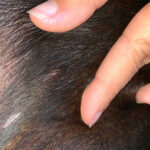 13 Pictures of Mast Cell Tumors in Dogs [With Vet Comments] - Mast cell tumors are the second most common cancerous tumor seen in dogs; they account… [...]
13 Pictures of Mast Cell Tumors in Dogs [With Vet Comments] - Mast cell tumors are the second most common cancerous tumor seen in dogs; they account… [...] The Stages of Mast Cell Tumors and Life Expectancy [With Pictures] - When you find a new lump on your dog, it’s easy to dismiss it as… [...]
The Stages of Mast Cell Tumors and Life Expectancy [With Pictures] - When you find a new lump on your dog, it’s easy to dismiss it as… [...]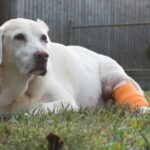 What is My Dog’s Life Expectancy With Mast Cell Tumor? A Vet Weighs In - Just this past week, I cared for a dog who was recovering from a large… [...]
What is My Dog’s Life Expectancy With Mast Cell Tumor? A Vet Weighs In - Just this past week, I cared for a dog who was recovering from a large… [...] What to Do When a Dog’s Mast Cell Tumor Itches, Bleeds, or Bursts - Mast cell tumors are a common skin cancer in dogs, accounting for 20% of all… [...]
What to Do When a Dog’s Mast Cell Tumor Itches, Bleeds, or Bursts - Mast cell tumors are a common skin cancer in dogs, accounting for 20% of all… [...]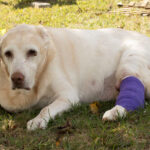 When to Euthanize Your Dog with Mast Cell Tumors [Veterinarian Advice] - The worst part about owning a dog is that their lives are far too short.… [...]
When to Euthanize Your Dog with Mast Cell Tumors [Veterinarian Advice] - The worst part about owning a dog is that their lives are far too short.… [...]Disclaimer: This website's content is not a substitute for veterinary care. Always consult with your veterinarian for healthcare decisions. Read More.


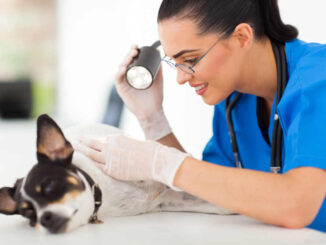
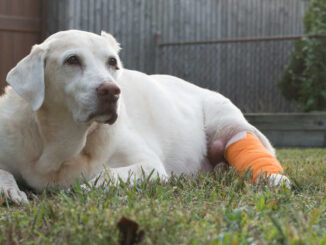
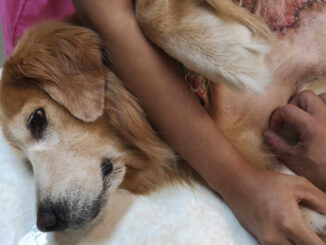
Be the first to comment